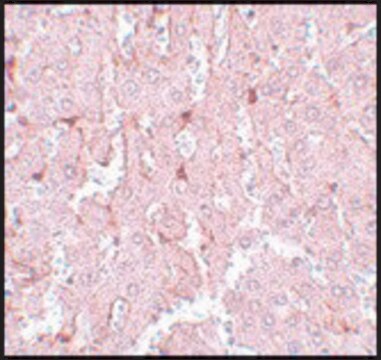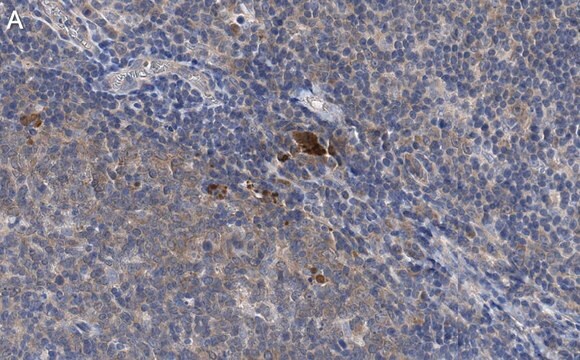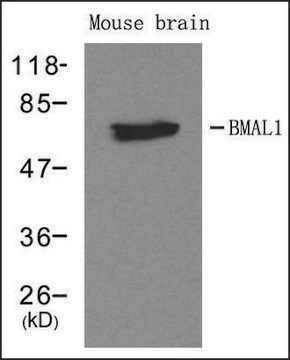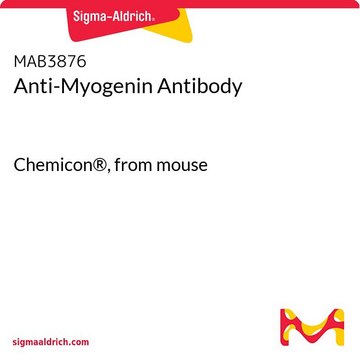일반 설명
We are committed to bringing you greener alternative products, which adhere to one or more of The 12 Principles of Green Chemistry.This antibody is Preservative-free, produced without the harm or sacrifice of animals and exceptionally stable to allow for ambient shipping and storage if needed and thus aligns with "Waste Prevention", "Designing Safer Chemicals" and "Design for Energy Efficiency".
Click here for more information.
ZooMAb® antibodies represent an entirely new generation of recombinant monoclonal antibodies. Each ZooMAb® antibody is manufactured using our proprietary recombinant expression system, purified to homogeneity, and precisely dispensed to produce robust and highly reproducible lot-to-lot consistency. Only top-performing clones are released for use by researchers. Each antibody is validated for high specificity and affinity across multiple applications, including its most commonly used application. ZooMAb® antibodies are reliably available and ready to ship when you need them.
특이성
Clone 1O16 is a ZooMAb® rabbit recombinant monoclonal antibody that specifically detects Nuclear factor of activated T-cells, cytoplasmic 1 (NFATc1). It targets an epitope within 17 amino acids from the internal region.
면역원
KLH-conjugated linear peptide corresponding to 17 amino acids from the internal region of human Nuclear factor of activated T-cells, cytoplasmic 1 (NFATc1).
애플리케이션
Quality Control Testing
Evaluated by Western Blotting with c-Myc/DDK-tagged full-length recombinant Human NFATc1 protein.
Western Blotting Analysis: A 1:10,000 dilution of this antibody detected c-Myc/DDK-tagged, full-length, recombinant Human NFATc1 protein.
Tested Applications
Immunocytochemistry Analysis: A 1:100 dilution from a representative lot detected NFATc1 in Jurkat cells.
Affinity Binding Assay: A representative lot of this antibody bound NFATc1 peptide with a KD of 1.0 x 10-12 in an affinity binding assay.
Enzyme Immunoassay (ELISA) Analysis: A serial of dilutions from a representative lot detected c-Myc/DKk-tagged, full-length, recombinant Human NFATc1 protein.
Immunohistochemistry (Paraffin) Analysis: A 1:100 dilution from a representative lot detected NFATc1 in Human tonsil tissue sections.
Note: Actual optimal working dilutions must be determined by end user as specimens, and experimental conditions may vary with the end user.
표적 설명
NuCLEAR™ factor of activated T-cells, cytoplasmic 1 (UniProt: O95644; also known as NF-ATc1, NFATc1, NFAT transcription complex cytosolic component, NF-ATc, NFATc) is encoded by the NFATC1 (also known as NFAT2, NFATC) gene (Gene ID: 4772) in human. NFATc1 is member of the multicomponent NFATC transcription complex that consists of at least two components, a pre-existing cytoplasmic component NFATC2 and an inducible NuCLEAR™ component NFATc1. NFATC proteins bind to DNA as monomers. NFATc1 that is expressed in thymus, spleen, and T-cells, plays a role in the inducible expression of cytokine genes, especially in the induction of the IL-2 or IL-4 gene transcription. NFATc1 is reported to control the cytotoxicity of mouse cytotoxic T lymphocytes. Upon primary stimulation of lymphocytes, the induction of NFATc1 occurs during the G1 phase of cell cycle. Due to an auto-regulatory feedback circuit high levels of NFATc1 are maintained during persistent immune receptor stimulation. It regulates not only the activation and proliferation, but also the differentiation and programmed death of T-lymphocytes as well as lymphoid and non-lymphoid cells. NFATc1 undergoes phosphorylation by NFATC-kinase and GSK3β and the phosphorylation induces its NFATc1 NuCLEAR™ exit. Its dephosphorylation by calcineurin promotes NuCLEAR™ import. The dephosphorylated form contains two unmasked NuCLEAR™ localization signals, which allow translocation of the protein to the nucleus. Ten different isoforms of NFATc1 have been described that are produced by alternative splicing and alternative initiation. This ZooMAb® recombinant monoclonal antibody, generated by our propriety technology, offers significantly enhanced specificity, Affinity™, reproducibility, and stability over conventional monoclonals. (Ref.: Serfling, E., et al. (2012). Cell Commun. Sig. 10; Article 16; Chuvpilo, S., et al. (1999). J. Immunol. 162(12); 7294-7301; Beals, CR., et al. (1997). Science. 275(5308). 1930-1934).
물리적 형태
Purified recombinant rabbit monoclonal antibody IgG, lyophilized in PBS, 5% Trehalose, normal appearance a coarse or translucent resin. The PBS/trehalose components in the ZooMAb formulation can have the appearance of a semi-solid (bead like gel) after lyophilization. This is a normal phenomenon. Please follow the recommended reconstitution procedure in the data sheet to dissolve the semi-solid, bead-like, gel-appearing material. The resulting antibody solution is completely stable and functional as proven by full functional testing. Contains no biocide or preservatives, such as azide, or any animal by-products. Larger pack sizes provided as multiples of 25 µL.
재구성
300 µg/mL after reconstitution at 25 µL per vial. Please refer to guidance on suggested starting dilutions and/or titers per application and sample type.
저장 및 안정성
Recommend storage of lyophilized product at 2-8°C; Before reconstitution, micro-centrifuge vials briefly to spin down material to bottom of the vial; Reconstitute each vial by adding 25 µL of filtered lab grade water or PBS; Reconstituted antibodies can be stored at 2-8°C, or -20°C for long term storage. Avoid repeated freeze-thaws.
기타 정보
Concentration: Please refer to the Certificate of Analysis for the lot-specific concentration.
법적 정보
Affinity is a trademark of Mine Safety Appliances Co.
NuCLEAR is a trademark of Sigma-Aldrich Co. LLC
ZooMAb is a registered trademark of Merck KGaA, Darmstadt, Germany
면책조항
Unless otherwise stated in our catalog or other company documentation accompanying the product(s), our products are intended for research use only and are not to be used for any other purpose, which includes but is not limited to, unauthorized commercial uses, in vitro diagnostic uses, ex vivo or in vivo therapeutic uses or any type of consumption or application to humans or animals.










